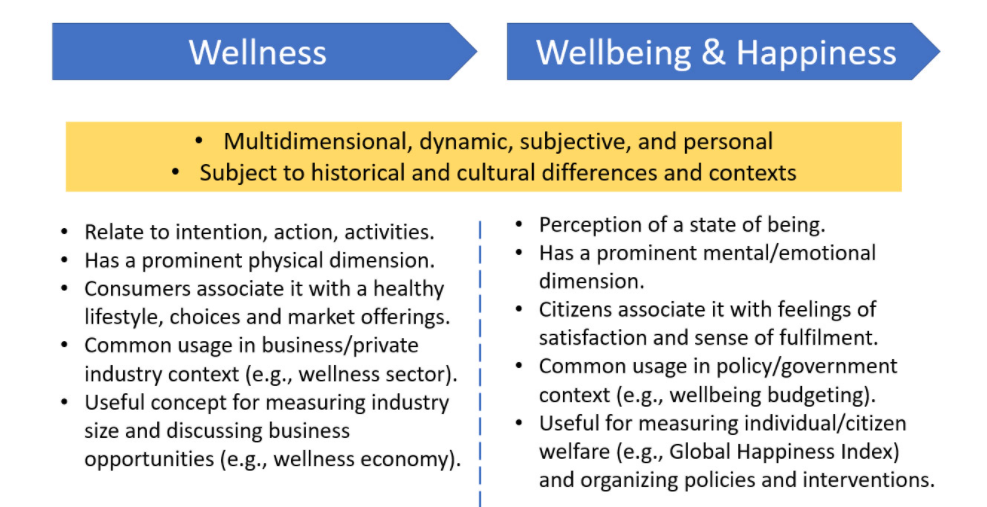-1.png?width=1260&name=Well%20workplace%20model%20(2)-1.png)
While the pandemic had changed our work and home lives in the short term, its impact of it in the long term remains to be seen around the world. An important outcome of the pandemic is the rise of interest in wellness and well-being, especially in the workplace.
In the last year, employers have become acutely aware of the importance of wellness and well-being for employees as they worked remotely. Now more than ever, organizations are focused on employee physical and mental health and should recognize the value of ergonomics.
There is a distinct and important interconnectedness between safety, wellness, well-being, and ergonomics which contributes to a good workplace.
What is Wellness?
The Global Wellness Institute defines wellness as the active pursuit of activities, choices, and lifestyles that lead to a state of holistic health. There are many dimensions to wellness, they include social connectedness, exercise, nutrition, sleep, and mindfulness. All part of what makes up our lifestyle. Wellness is acutely connected to health, which is essentially a state of complete physical, mental and social well-being, and not merely the absence of disease or sickness. It is something we actively pursue.
Wellness is driven by our self-responsibility for our own choices, behaviors, and lifestyles—but it is also significantly influenced by the physical, social and cultural environments in which we live and work.
Wellness is about more than just physical health. Most models of wellness include at least 6 dimensions but some include more. The six most popular aspects of wellness are:
- Physical: A healthy body through exercise, nutrition, sleep, etc.
- Mental: Engagement with the world through learning, problem-solving, creativity, etc.
- Emotional: Being in touch with, aware of, accepting of, and able to express one’s feelings (and those of others).
- Spiritual: Our search for meaning and purpose in human existence.
- Social: Connecting with, interacting with, and contributing to other people and our communities.
- Environmental: A healthy physical environment free of hazards; awareness of our role in bettering rather than denigrating the natural environment.
Wellness vs. Well-being
Well-being is the state of being comfortable, healthy, and happy. Well-being is in the self-interest of the person. The terms “wellness,” “well-being,” and “happiness” have often been used together or interchangeably by businesses, researchers, and the media. This graphic outlines what they share in common, and how these terms differ in concept, usage, and association.

What is Workplace Wellness?
The history of workplace wellness starts with the Italian physician, Bernardini Ramazzini (1633-1714) who is believed to be one of the first to write about the effects of work exposure on workers (occupational diseases) and was interested in the possibilities of taking preventative measures (Gainer, 2008) to help improve employee well-being.
In recent years, workplace wellness has gained significant popularity. Rooted in the mid-'70s and '80s with a focus on executive and employee physical fitness to reduce stress levels, and improve health outcomes, expanded to the concept of a well-workplace.
Workplace wellness includes expenditures on programs, services, activities, and equipment by employers aimed at improving their employees’ health and wellness. These expenditures aim to raise awareness, provide education, and offer incentives that address specific health risk factors and behaviors (e.g., lack of exercise, poor eating habits, stress, obesity, smoking) and encourage employees to adopt healthier lifestyles. By doing so, employers benefit from reduced health care costs, reduced injury rates, workers' compensation premiums, and an overall healthier and safer workplace.
The Connection to Ergonomics
Ramazzini is the father of Occupational Medicine and is forever tied to the practice of wellness and well-being. But he is also responsible for identifying the effects of ergonomic risk factors on workers. In his book on occupational diseases, De Morbis Artificum Diatriba (Diseases of Workers) outlined the health hazards of chemicals, dust, metals, repetitive or violent motions, odd postures, and other disease-causative agents encountered by workers in more than fifty occupations.
Ergonomics as defined by the International Ergonomics Association as the scientific discipline concerned with the understanding of interactions among humans and other elements of a system, and the profession that applies theory, principles, data, and methods to design in order to optimize human well-being and overall system performance.
As a result, ergonomics has an important role to play in workplace wellness and the well-being of employees. Therefore, it is critical to include and elevate your ergonomics program as part of your safety and wellness programs.
Integrating Ergonomics into Your Organization's Wellness Strategy
Ergonomics takes into account physical, cognitive, sociotechnical, organizational, environmental and other relevant factors, as well as the complex interactions between the human and other humans, the environment, tools, products, equipment, and technology.
The interconnectedness of wellness, well-being, and ergonomics is clear! Pandemic aside, employers should understand this important relationship. One doesn't exist without the other. Wellness includes the physical, mental, emotional, and environmental components; so do ergonomics! Employees need to understand the importance of ergonomics at work, especially as it relates to computer use and other essential work tasks.
Ergonomics is the Intersection of a Well Workplace
The intersection between wellness and well-being is ergonomics creating a good workplace. Ergonomics, wellness, and well-being are critically interconnected strategies for all employers to impart to employees.
As we move beyond the pandemic and adapt to our new ways of working anywhere, these strategies will become increasingly important to organizations and employees. The question is your organization ready?
Comment below on how your organization is offering ergonomics, wellness, and well-being to create a good workplace. Our focus at Worksite International has always been to support organizations with a healthy and well workplace.
Learn more about becoming a Certified Ergonomics Process Leader here. Available only through Worksite International's Ergonomics Training Academy.
Resources:
- https://globalwellnessinstitute.org/industry-research/industry-trends
- https://michaelrucker.com/well-being/the-history-of-workplace-wellness
- https://en.wikipedia.org/wiki/Bernardino_Ramazzini
- https://iea.cc/what-is-ergonomics


Comments